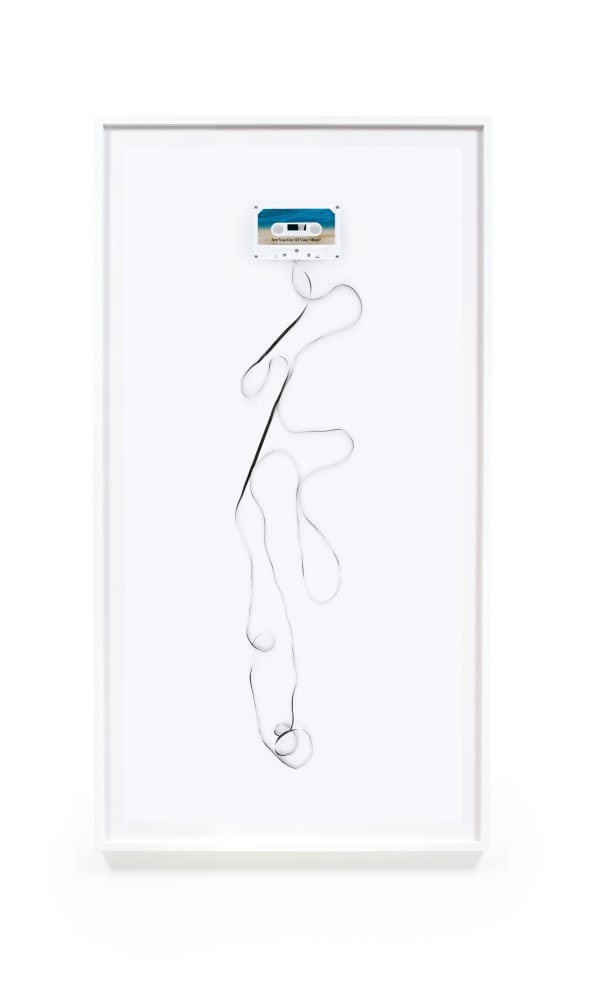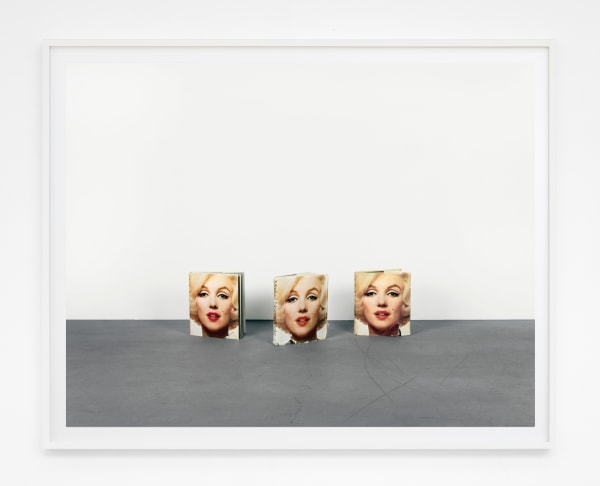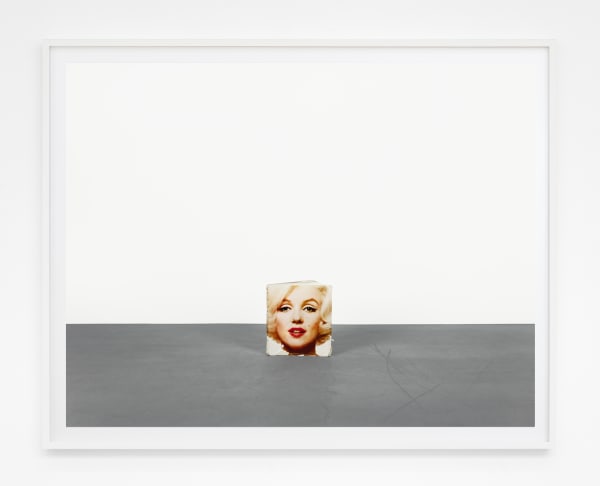Anne Collier: Portraits
“What do we see when we look at Anne Collier’s photographs? Borrowing from psychoanalytic feminist literary theory, today I see a kind of female jouissance: a pleasure and pain that is at once erotic, mystical, and political. A feminine libidinal drive repressed by the symbolic order. The inner life of photographs.” (Polly Staple, 2025.)
Anton Kern Gallery is pleased to present Portraits Anne Collier’s seventh solo exhibition at the
gallery. Early in her career Collier described her practice as a form of “deflected self-portraiture,” wherein the objects that she documented - including her now celebrated works incorporating images of record sleeves, magazine covers, book pages, etc. - embraced the idea that they might be avatars or surrogates for the artist herself. The current exhibition will include key works from this era, including Studio Floor (Marilyn, Norman Mailer) and Untitled (This Charming Man), both 2009. Yet throughout her practice Collier has periodically returned to the genre of portraiture itself: creating images - depictions and representations - of other individuals, including friends and artists in her immediate circle. For her latest exhibition at Anton Kern, Collier presents works made between 2003 and 2025, structured around two important series: her rarely seen Aura Polaroid portraits produced in Oakland, CA, between 2003 and 2004, and her ongoing series Developing – close-up photographic ‘portraits’ of people’s eyes suspended in darkroom developing trays - which was initiated in 2009.
Collier’s Aura portraits were created during the artist’s time living in Oakland, California. They were made in a downtown Oakland psychic store using a modified Polaroid camera that its creators claimed could both capture and visualize the sitter’s energy field or aura. Each of the aura portraits is accompanied by a computer-generated printout, ‘analyzing’ the resulting hyper-saturated chromatic images. Over the course of two years Collier took local friends as well as artists visiting the Bay Area to the psychic store to sit for an aura portrait. Eventually, she made more than forty such portraits, including those of artists John Baldessari, Mike Kelley, Frances Stark, Cerith Wyn Evans, Vincent Fecteau and the writers Dodie Bellamy and Kevin Killian, among others. Given the absence of scientific evidence to rationalize or legitimize the promise of aura photography, Collier’s images operate instead within photography’s long-established entanglements with questions of veracity and belief: ideas that have been inherent to the medium since the emergence of, say, late 19 th century ‘spirit’ photography to Susan Hiller’s and Mike Kelley’s more recent investigations into photographic manifestations of psychic phenomena. Writing about her own uncertain relationship with auras, in a text that accompanies Collier’s exhibition, Alissa Bennett suggests: “I thought it was a nice idea that the catastrophic jumble in my brain might have transmuted into a golden cloud that hovered around my person, but it seemed too new age-y to buy into, like a fantasy from another time.”
In her ongoing Developing series, which began in 2009 with a now iconic self-portrait work -Developing Tray #2 (Gray) – Collier continues to explore her interest in the formal languages and technical apparatus of the analog photographic process. Staged in the studio, and shot with Collier’s typical forensic precision, each of the Developing works depict an enlarged image of an individual’s left eye (with the studio lighting clearly evident, and reflected in their irises and pupils,) which is then produced as a 8” x 10” black and white photographic print, which in turn is suspended - and ‘framed’ - in a darkroom developing tray, with the sitter’s tear duct in alignment with the tray’s pouring lip. In this series Collier encourages multiple readings and interpretations around the word ‘developing,’ considering how it relates to the literal analog photographic process, to the ongoing evolution of her own practice, as well as to how the notion of development relates to ideas of aging, and to personal, emotional and psychological growth. As with her earlier Aura portraits the subjects of the Developing series are drawn from the artist’s circle of friends and peers – including the dancer and choreographer Vinson Fraley, the chef Dalad Kambhu, and the artist Klara Liden, among others – and when seen together both series propose or suggest not so much “deflected self portraiture,” but rather something more collaborative or collegial even, something akin to a form of social portraiture.
In her text written to accompany this exhibition Alissa Bennett concludes:
“It’s interesting to think about the difference between looking with the eye and looking with the camera. The camera seems to me like it’s a simple tool, like a can opener or a pair of scissors, a device that pries the lid off something so that we can see inside of it. I think Anne knows that, which is why she uses it to isolate the brief moments when feelings like love or loneliness or longing rush up from inside of us and flood our surfaces, things that are too fast or too fugitive for us to register in the maelstrom of everyday life. Maybe if we had apertures instead of pupils, we could quiet things down and see what she sees …”
-
 Anne CollierDeveloping (Comic), 2024
Anne CollierDeveloping (Comic), 2024 -
 Anne CollierDeveloping (Klara Lidén), 2024
Anne CollierDeveloping (Klara Lidén), 2024 -
 Anne CollierAura (John Baldessari), 2003
Anne CollierAura (John Baldessari), 2003 -
 Anne CollierAura (Jeffrey Valence), 2003
Anne CollierAura (Jeffrey Valence), 2003
-
 Anne CollierAura (Cameron Jamie), 2003
Anne CollierAura (Cameron Jamie), 2003 -
 Anne CollierAura (Frances Stark), 2003
Anne CollierAura (Frances Stark), 2003 -
 Anne CollierAura (Eric Kroll), 2003
Anne CollierAura (Eric Kroll), 2003 -
 Anne CollierAura (Arnold Kemp), 2003
Anne CollierAura (Arnold Kemp), 2003
-
 Anne CollierUnraveling, 2024
Anne CollierUnraveling, 2024 -
 Anne CollierDeveloping (Dalad Kambhu), 2024
Anne CollierDeveloping (Dalad Kambhu), 2024 -
 Anne CollierAura (Thomas Hirschhorn), 2003
Anne CollierAura (Thomas Hirschhorn), 2003 -
 Anne CollierAura (Cerith Wyn Evans), 2003
Anne CollierAura (Cerith Wyn Evans), 2003
-
 Anne CollierAura (Vincent Fecteau), 2003
Anne CollierAura (Vincent Fecteau), 2003 -
 Anne CollierAura (Dodie Bellamy), 2003
Anne CollierAura (Dodie Bellamy), 2003 -
 Anne CollierAura (Kevin Killian), 2003
Anne CollierAura (Kevin Killian), 2003 -
 Anne CollierDeveloping (Vinson Fraley), 2025
Anne CollierDeveloping (Vinson Fraley), 2025
-
 Anne CollierAura (Mike Kelley), 2003
Anne CollierAura (Mike Kelley), 2003 -
 Anne CollierDeveloping (Anonymous), 2025
Anne CollierDeveloping (Anonymous), 2025 -
 Anne CollierDeveloping, 2024
Anne CollierDeveloping, 2024 -
 Anne CollierDeveloping (Comic) #2, 2025
Anne CollierDeveloping (Comic) #2, 2025
-
 Anne CollierStudio Floor #3 (Marilyn, Norman Mailer), 2009
Anne CollierStudio Floor #3 (Marilyn, Norman Mailer), 2009 -
 Anne CollierStudio Floor #2 (Marilyn, Norman Mailer), 2009
Anne CollierStudio Floor #2 (Marilyn, Norman Mailer), 2009 -
 Anne CollierStudio Floor #1 (Marilyn, Norman Mailer), 2009
Anne CollierStudio Floor #1 (Marilyn, Norman Mailer), 2009 -
 Anne CollierAura (Anne Collier), 2003
Anne CollierAura (Anne Collier), 2003
-
Anne Collier: Portraits | Anton Kern Gallery
Museé, June 20, 2025 -
ANNE COLLIER: “PORTRAITS” AT ANTON KERN GALLERY, NEW YORK
Jackson Davidow, Dear Dave, June 11, 2025 -
What Even Is a Body? John Vincler Looks for the Corporeal in New York Gallery Shows Up Now
John Vincler, Cultured, June 4, 2025 -
Incorrect Ideologies
Linda Yablonsky, Artforum, May 16, 2025











































